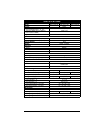
EN - 31
CLUTCH ADJUSTMENT
If clutch fails to engage or disengage properly
or begins to make abnormal noise, check the
air gap adjustment at the three inspection
slots.
To check:
1. Stop engine, remove key and wait for all
hot parts to cool.
2. Measure the air gap between the
armature and the rotor.
Minimum: A .016" feeler gauge should
slide between armature and rotor with
slight contact.
Maximum: A .020" feeler gauge should
slide between armature and rotor with
slight contact.
3. Repeat for each inspection slot.
To adjust:
1. If necessary, loosen gap adjustment
nuts until a .016" feeler gauge fits
between armature and rotor.
2. Slide a .020" feeler gauge between
armature and rotor.
3. Tighten gap adjustment nut until there is
slight contact on feeler gauge.
4. Repeat steps 1 – 3 at each inspection
slot.
NOTE: Adjust air gap as evenly as possible.
5. Start unit, engage and disengage PTO.
6. Shut off unit.
7. Recheck air gap and adjust if needed.
SHORT TERM
NEVER spray unit with high-pressure water
or store unit outdoors.
Inspect unit for visible signs of wear,
breakage or damage.
Keep all nuts, bolts and screws properly
tightened and know unit is in safe working
condition.
Store unit in a cool, dry protected area.
LONG TERM
Clean unit thoroughly with mild soap and low
pressure water and lubricate (See Lubricate
Unit on page 24 in Maintenance). Touch up
all scratched painted surfaces.
Remove weight from wheels by putting
blocks under frame or axle.
When storing unit for extended periods of
time, remove all fuel from tank and carburetor
(run dry). Refer to Engine Manual.
Clean and charge the battery. Charge battery
every three to four weeks when storing unit.
Fuel System
Gasoline left in the fuel system for extended
periods without a stabilizer will deteriorate,
resulting in gum deposits in the system.
These deposits can damage the carburetor
and the fuel hoses, filter and tank. Prevent
deposits from forming in the fuel system
during storage by adding a quality fuel
stabilizer to the fuel. Follow the
recommended mix ratio found on the fuel
stabilizer container.
To treat the fuel system for storage:
1. Add fuel stabilizer according to
manufacturers’ instructions.
2. Run engine for at least 10 minutes after
adding stabilizer to allow it to reach the
carburetor.
NEVER store the engine with fuel in the fuel
tank inside of a building with potential
sources of ignition.
To Take the Unit Out of Storage
1. Refer to the engine service manual to
prepare the engine for service.
2. Put fresh, clean fuel in the fuel tank.
3. Begin the maintenance schedule.
4. Charge and install the battery.
Figure 22
1. Armature
2. Rotor
3. Inspection Slot
4. Gap Adjustment Nut
1
2
3
4
4
STORAGE
WARNING: AVOID INJURY.
Read and understand entire
Safety section before proceeding.


















